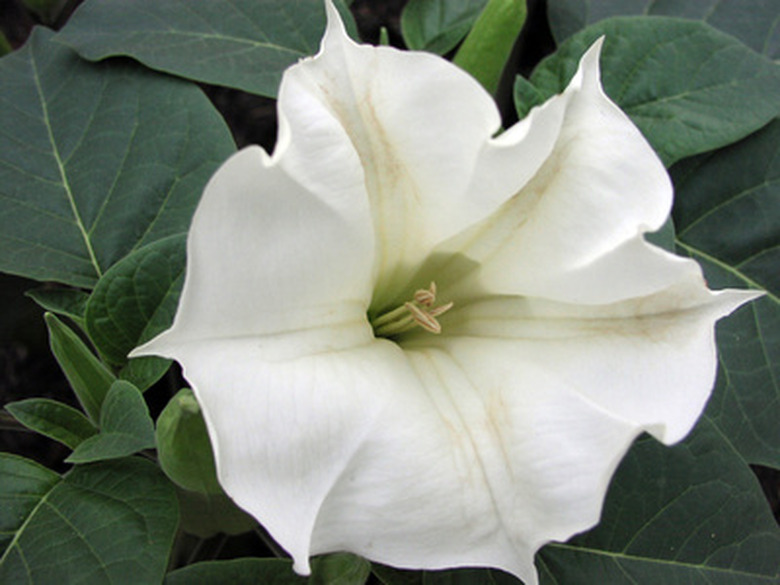Flowers That Bloom At Dusk
Whether you spend your nights up and about or sleeping peacefully, flowers that bloom at dusk provide a contrast to typical day-blooming varieties. Sometimes fragrant, sometimes rare, night-blooming flowers provide a distinct opportunity for enjoyment for those who have the time to enjoy their gardens in the evening hours.
Moonflowers
Moonflowers (Ipomoea alba) are close relatives to morning glories. Like their cousins, they grow on long, trailing vines of 12 feet or more. An annual plant in all but its native Central America, moonflowers are marked by large, white flowers that open at dusk and close by dawn. Flowers are solitary and measure about 6 inches across. Described as looking like stars, the flowers are surrounded by heart-shaped leaves. The stems spiral counter-clockwise regardless of treatment or habitat. Moonflowers tolerate a variety of soils, but need regular watering to survive. They should only be planted when temperatures reach 65 degrees Fahrenheit or above, and they require six hours of daytime light, according to the University of Arkansas Extension Office.
- Whether you spend your nights up and about or sleeping peacefully, flowers that bloom at dusk provide a contrast to typical day-blooming varieties.
- An annual plant in all but its native Central America, moonflowers are marked by large, white flowers that open at dusk and close by dawn.
Evening Primrose
The common evening primrose (Oenothera biennis) is a biennial plant that flowers at night. Characterized by bright yellow blooms, evening primrose is a fragrant flower that blooms for one or two days at a time. Variations within the plant exist, making it possible for the plants to grow between 1 and 8 feet tall. Flowering from June through October in most areas, evening primrose thrive in well-drained soil and full sun. Plants self-sow and are considered invasive in many areas, according to the USDA Plant Guide.
Night Blooming Cereus
Night blooming cereus is known scientifically as Selenicerus grandiflorus. Members of the cactus family, these flowers originate in Mexico, Central America and the Caribbean. Also called the Queen of the Night, Selenicerus grandiflorus plants create only one bloom a year or every several years, with blooms that last mere hours. Night blooming cereus needs areas of full sun during the day and dry, sandy soil rich with organic matter. Night blooming cereus prefers medium to high humidity and should be misted periodically throughout the spring and summer growing months. Night blooming cereus does best in temperatures similar to those found in its native habitats, preferably between 60 to 85 degrees Fahrenheit, according to "Passalong Plants."
- The common evening primrose (Oenothera biennis) is a biennial plant that flowers at night.
- Also called the Queen of the Night, Selenicerus grandiflorus plants create only one bloom a year or every several years, with blooms that last mere hours.
Four O'Clocks
Native to North America, four o'clock flowers are members of the Mirabilis genus. These perennials grow between 2 and 4 feet tall and may be spreading or bush-like. Flowers vary in color from white, to shades of pink and purple, to a rich blue color. They are funnel-shaped and cluster in groups of one to five. The plants are named due to their habit of opening in the late afternoon or early evening. Four o'clocks do best in dry, sandy or gravelly soil. Despite their need for well-drained soils, four o'clocks should be watered on a regular basis, according to the Utah State University Extension Office.
- Native to North America, four o'clock flowers are members of the Mirabilis genus.
- These perennials grow between 2 and 4 feet tall and may be spreading or bush-like.
References
- University of Arkansas: Moonflower
- USDA Plant Guide: Common Evening Primrose (PDF)
- Utah State University: Four o'clock
- "Planning & Planting a Moon Garden"; Marcella Shaffer; 2001
- "Passalong Plants"; Steve Bender, Felder Rushing; 2002
